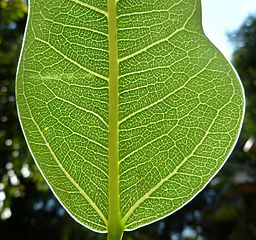Ficus salicifolia
| Ficus salicifolia | |
|---|---|

| |
| In Pretoria, South Africa | |
| Scientific classification | |
| Kingdom: | Plantae |
| Clade: | Tracheophytes |
| Clade: | Angiosperms |
| Clade: | Eudicots |
| Clade: | Rosids |
| Order: | Rosales |
| Family: | Moraceae |
| Genus: | Ficus |
| Species: | F. salicifolia
|
| Binomial name | |
| Ficus salicifolia | |
| Synonyms | |
| |
The Wonderboom (Ficus salicifolia) is an evergreen fig species that ranges from the KwaZulu-Natal midlands northwards to tropical East Africa.[1] It grows especially on outcrops, rocky hillsides and along cliffs fringing water courses and may rarely[2] grow up to 10 m tall, and acquire a leafy spreading crown.[1]
Description[]
The elliptic-oblong, leathery leaves of about 7 to 10 cm long, are carried on long petioles, and are often noticeably folded along the midrib. The leaf sides are almost parallel and clear net-veining is visible on the lamina.[2] Leaves are brittle and have a characteristic smell when broken or bruised. The leaves are toxic and cause nervous disorders or even deaths in cattle.[3]
The small, smooth figs are carried on short stalks and measure about 4–6 mm in diameter. They are massed along the branchlets in the leaf axils,[2] and change from white to yellowish-red and spotted as they ripen.[1] The figs are eaten by birds and mammals.[3]
Similar species[]
It may be confused with the similar but deciduous Ficus ingens which grows in similar habitat. The latter has somewhat larger, white to purple figs, and deep red fresh foliage.[1] The Wonderboom fig is sometimes deemed a race of Ficus cordata,[4] i.e. F. c. subsp. salicifolia (Vahl) C.C.Berg, though the latter species has yellowish sessile figs and a more westerly distribution.
Distribution and habitat[]

It occurs in the Saharo-montane woodlands of the Tassili n'Ajjer, the Hoggar, Aïr and Tibesti mountains, the Kerkour Nourene massif and at Elba mountain in the Red Sea Hills.[5] It is widespread in the eastern Afrotropics, from southern Arabia and Socotra to the KwaZulu-Natal midlands of South Africa.[6][7]
The Wonderboom grove[]
The species is named after the Wonderboom grove in Pretoria, that has spread from a central bole that was carbon dated to about 1,000 years old.[1][2] The Wonderboom is an extraordinary specimen for its size and structure, and its drooping branches are continuing to root and form new trees.[2] Their branches reach about 23 metres into the sky, and one of the boles has a girth of 5½ metres.[8]
Ecology[]
The pollinator wasp is Platyscapa awekei Wiebes., while non-pollinating wasps include Mayr and van Noort.[7]
Gallery[]

Diagnostic rounded leaf base, regular lateral venation and unbranched, curved basal pair

The figs on short stalks

The Wonderboom grove near Pretoria
References[]
- ^ a b c d e Palmer, Eve (1977). A Field Guide to the Trees of Southern Africa. London, Johannesburg: Collins. pp. 91–93. ISBN 0-620-05468-9.
- ^ a b c d e Palgrave, K.C. (1984). Trees of Southern Africa. Cape Town: Struik. pp. 113–114. ISBN 0-86977-081-0.
- ^ a b Van Wyk, Braam; et al. (1997). Field Guide to the Trees of Southern Africa. Cape Town: Struik. p. 78. ISBN 1-86825-922-6.
- ^ "Ficus salicifolia Vahl". ThePlantList. Retrieved 15 February 2013.
- ^ "Ficus cordata subsp. salicifolia (Vahl) C.C. Berg". African Plant Database. Conservatoire et Jardin botaniques & South African National Biodiversity Institute. Retrieved 5 May 2013.
- ^ "Records: Ficus salicifolia Vahl". Tropicos. Missouri Botanical Garden. Retrieved 4 November 2014.
- ^ a b van Noort, S., Rasplus, J. "Ficus salicifolia Vahl 1790". Figweb. iziko museums. Archived from the original on 5 November 2014. Retrieved 5 November 2014.
- ^ Tim. "Wonderboom figs (Ficus salicifolia) in South Africa". Monumental Trees. Retrieved 14 November 2019.
![]() Media related to Ficus salicifolia at Wikimedia Commons
Media related to Ficus salicifolia at Wikimedia Commons
- Trees of Africa
- Flora of Southern Africa
- Taxa named by Martin Vahl
- Ficus


